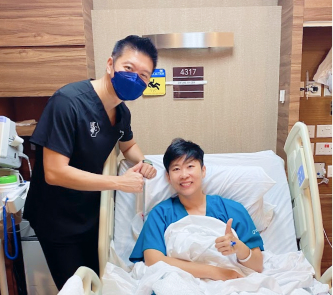Carpal Tunnel Syndrome

What is the Carpal Tunnel?
The carpal tunnel is a narrow passageway located in the anterior portion of the wrist. It comprises carpal bones at the bottom and sides of the tunnel and a strong fibrous ligament, called the transverse carpal ligament forming the roof of the tunnel. Within the carpal tunnel is the median nerve which provides sensation to the thumb, index, middle fingers, and half of the ring finger (except the pinky finger). In addition, it controls the muscles surrounding the base of the thumb. The carpal tunnel also comprises nine tendons (flexor tendons) that facilitate the bending of the fingers and thumb. This structure allows the median nerve and tendons to pass through to connect the hand and forearm.
What is Carpal Tunnel Syndrome?
Carpal tunnel syndrome (CTS) is a condition that occurs when the median nerve becomes compressed or squeezed as it passes into the wrist joint, or when the tissues surrounding the tunnel swell. The pressure on the median nerve reduces blood supply, causing some nerve fibres to degenerate and impair the sensation in the hands and fingers.
What Causes Carpal Tunnel Syndrome?
Excessive pressure on the wrist and median nerve can lead to carpal tunnel syndrome, causing numbness, tingling, and weakness in the hand. It may arise from fractures of the wrist, fluid retention, and inflammatory conditions such as rheumatoid arthritis, which leads to swelling of the tendons and joints.
What are the Risk Factors?
Although they do not directly cause the condition, these factors may increase the risk of irritation or damage to the median nerve. They include:
- Gender – Women have a higher chance of developing carpal tunnel syndrome as they have a smaller carpal tunnel size than men.
- Age – The risk of developing carpal tunnel syndrome tends to increase with age, typically affecting individuals between the ages of 40 and 60.
- Repetitive hand and wrist movements – Engaging in repetitive hand and wrist motions, such as typing on a keyboard for an extended period may aggravate the wrist tendons.
- Injury or trauma – Wrist fracture, dislocation, and other wrist-related injuries may cause swelling and inflammation within the wrist area and median nerve compression.
- Hormonal changes – Fluctuations in hormones during pregnancy or menopause may cause fluid retention and exacerbate the symptoms of carpal tunnel syndrome.
- Obesity – Being obese or overweight may lead to increased pressure on the median nerve.
- Medical conditions – Certain medical conditions like rheumatoid arthritis, diabetes, and thyroid gland imbalance (hypothyroidism) may increase the risk of developing carpal tunnel syndrome.
What are the Symptoms of Carpal Tunnel Syndrome?
Symptoms often develop gradually over time. Common ones include:
- Pain – Individuals with carpal tunnel syndrome may feel pain in either one or both hands, wrists, and fingers. This discomfort may sometimes radiate up the arm.
- Numbness and tingling – Some may experience numbness and tingling in the thumb, index, middle, and half of the ring finger; or even a sensation of pins and needles through their fingers.
- Weakness – As carpal tunnel syndrome progresses; individuals may develop weakness in their hand muscles and decreased grip strength.
- Nighttime discomfort – As most individuals sleep with their wrists curled, patients with carpal tunnel syndrome often experience increased symptoms at night.
How is Carpal Tunnel Syndrome Diagnosed?
When diagnosing carpal tunnel syndrome, doctors normally begin with a thorough physical examination and review of the patient’s symptoms and medical history. The doctor may tap the palm side of the patient’s wrist over the median nerve to determine if there is any tingling sensation in the fingers (Tinel’s Sign test).
The orthopaedic surgeon may also perform additional tests to confirm the diagnosis, including:
- Electromyography (EMG) – This test involves inserting thin needle electrodes into the muscles of the hand and forearm to measure their electrical activity. Any abnormalities in muscle electrical activity may indicate nerve dysfunction or damage.
- Nerve Conduction Study (NCS) – This method involves placing electrodes into the skin to measure the speed and strength of nerve signals. It also helps determine whether the median nerve is functioning and identifies any areas of nerve compression or damage.
- Imaging Tests – X-rays, ultrasounds, or magnetic resonance imaging (MRI) may be performed to help visualise the bones, tendons, ligaments, and nerves in the wrist and hands. These imaging tests can also detect any structural abnormalities, such as fractures or arthritis, that may be contributing to the symptoms.
Treatments for Carpal Tunnel Syndrome
For patients experiencing mild to moderate symptoms, non-surgical interventions are often the first line of treatment. These include:
- Wrist splinting – Wearing a brace or splint, especially at night, helps stabilise the wrist and reduce pressure on the median nerve.
- Medications – Doctors may recommend nonsteroidal anti-inflammatory drugs (NSAIDs) to help with the inflammation and discomfort. In some cases, corticosteroids may be prescribed to reduce inflammation and swelling around the median nerve.
- Physiotherapy – Hand therapy exercises and stretches can ease symptoms and increase strength, flexibility, and range of motion in the hand.
Surgical intervention may be recommended when non-surgical treatments fail to provide sufficient relief or symptoms worsen. There are two carpal tunnel release surgical techniques:
- Open surgery – In this procedure, the surgeon creates an incision in the palm of the hand to access the carpal tunnel. The transverse carpal ligament is then divided to create more space for the median nerve, thereby relieving pressure.
- Endoscopic surgery – This technique involves using a small camera (endoscope) and specialised surgical instruments. The surgeon makes one or two small incisions in both the wrist and palm regions and inserts the endoscope into position to examine the carpal tunnel. They will then use a surgical knife and carefully divide or cut through the transverse carpal ligament.
Recovering from Carpal Tunnel Surgery
While individual factors vary and can contribute to slightly differing recovery periods, it generally takes 3-4 months to a year to fully regain one’s hand function and strength.
Following surgery, the patient will wear a splint for 1-2 weeks to support the wrist. They will also be encouraged to move their fingers to prevent stiffness. During this period, there may be temporary discomfort, swelling, and weakness, which will subside following physiotherapy and pain medications. During physiotherapy, the patient will be guided on various exercises to strengthen the hand and wrist and improve mobility.
Can Carpal Tunnel Syndrome be Prevented?
Here are some tips you can follow to minimise the risk of developing carpal tunnel syndrome:
- Take frequent breaks from activities that require repeated hand and wrist movements.
- Ensure proper posture and ergonomics while performing tasks that may cause hand and wrist strain.
- Use ergonomic tools and equipment that promote proper hand and wrist alignment.
- Practise hand and wrist exercises and stretches to help maintain mobility and strength.
- Manage any underlying medical conditions, such as diabetes or arthritis.
Frequently Asked Questions
Can carpal tunnel syndrome go away on its own?
In some cases, mild symptoms of carpal tunnel syndrome may subside through sufficient rest and conservative methods, such as wearing splints and modifying one’s activities. However, it is unlikely that the condition will completely resolve on its own without proper medical intervention.
What can I do to relieve carpal tunnel pain?
You may rest your hands and wrists following repetitive movements, apply cold packs to the affected area, take over-the-counter pain medications, wear a wrist splint, and engage in gentle exercises targeted at the hands and wrists. If the pain persists or affects your daily life, do not hesitate to seek medical attention.
Our Carpal Tunnel Surgeon in Singapore
FRCSEd (Orth), FAMS
Dr Kevin Koo is a skilled carpal tunnel surgeon with over 20 years of experience in orthopaedic surgery. Dr Koo completed a fellowship at St. Mary's and Charing Cross Hospitals, Imperial College Healthcare in London, UK, where he worked with internationally recognised orthopaedic surgeons and treated professional athletes and dancers.
His practice interests include foot and ankle surgery, joint replacements, sports and minimally invasive surgery. He has presented extensively at international, regional as well as local conferences including the prestigious American Academy of Orthopaedic Surgeons (AAOS) as well as the British Society for Surgery of the Hand (BSSH) Annual Scientific Meetings.



| Tel. | : +65 6970 5905 |
| Fax | : +65 6970 5906 |
| Mobile | : +65 9898 7781 |
| : hello@bjc.sg , drkevinkoo@bjc.sg |
| Mon - FriMonday to Friday | :8:30am to 5:30pm |
| Sat, Sun and PHSaturday, Sunday & PH | :Closed |
Well-being: Our Focus at
The Bone & Joint Centre.
get in touch as soon as possible.
| Tel. | : +65 6970 5905 |
| Fax | : +65 6970 5906 |
| Mobile | : +65 9898 7781 |
| : hello@bjc.sg , drkevinkoo@bjc.sg |
| Mon - FriMonday to Friday | :8:30am to 5:30pm |
| Sat, Sun and PHSaturday, Sunday & PH | :Closed |





